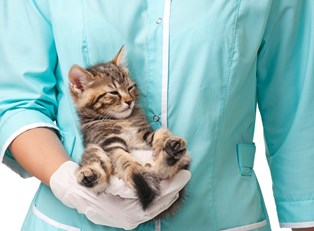For some, strong affection for animals is the driving force behind becoming a vet tech. However, consider the fact that the job is not all warm and fuzzy and neither are the animals. As an assistant to the veterinarian, techs regularly come in contact with harmful microbes, blood, feces, urine and vomit. Animals often become angry or frightened, which often leads to biting, kicking, clawing and scratching. Large animals require lifting or restraining. Situations may become dangerous when working with many different animals. Potential techs must be fully aware of the possible situations and duties of the career.
Working with Animals and People
Some aspiring techs find the career option appealing because they because being around animals seems more enjoyable than being around people. Animals are more loyal, do not complain and more often show appreciation. However, once again, animals may present a danger when attempting to provide beneficial care.
Techs must also realize that before dealing with an animal, clinical staff must work closely with the animal's owner. Having a good rapport with clients requires good communication and listening skills. Owners may need educational guidance in the care of pets, explanations of disease processes, medical conditions or treatments. Sometimes owners must receive bad news. Technicians may be called upon to handle any of these situations. There will be confrontations with owners who are not amiable.
Educational Requirements
While some states and private practices may allow individuals without training to work side by side with a veterinarian, these people are more commonly referred to as assistants and not technicians. The pay is also often less for someone not having a formal education. More and more, states require that technical positions require at least a two-year associate degree from an accredited program.
After completing the program, students are eligible to take the credentialing examination required by the state. Many states use a generalized National Veterinary Technician exam. Licenses and credential transfer from one state to another as long as both states use the same exam.
Work Environment
Licensed veterinary technicians may gain employment in a variety of settings. Animal shelters, emergency animal hospitals, private veterinary clinics, research laboratories or zoos. Though some of the occupation options seem appealing or even glamorous, the U.S. Bureau of Labor Statistics (BLS) advises that technicians working full-time suffer more job related injuries and illnesses compared to the national average.
Employment Outlook
The BLS reports that employment opportunities for licensed veterinary technicians remains high, as classes are typically small and programs do not produce enough graduates to meet demands. Historically, surveys indicate that technicians do not stay in the field for more than a decade, which means replacement employees are needed. Regardless of the economy, the position offers job security because animals will always require at least basic medical care.
Salaries
Veterinary technician salaries range from $20,000 to $40,000 annually and are based on education level, years of experience, technical field, and geographical location of the job. While many dream of working in an aquarium, research and rescue facility or zoo, these are highly competitive positions that are not always available.



